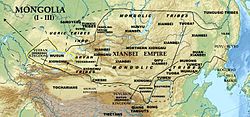Chuban
| Yueban | |||||
|
|||||
| Capital | Not specified | ||||
| Government | Not specified | ||||
| Historical era | 1st millennium | ||||
| • | Established | 160 | |||
| • | Disestablished | 490 | |||
| Today part of |
|
||||
Yueban (Chinese: 悅般), also written Üeban, Urpen literally: "Weak Xiongnu") was the name used by Chinese historians for remnants of the Xiongnu in Zhetysu, now part of modern-day Kazakhstan. In Chinese literature they commonly called Yueban. The Yuebans gained their own visibility after disintegration of the Eastern Xiongnu state, because unlike the main body of the Northern Xiongnu, who escaped from the Chinese sphere of knowledge, the Yueban tribes remained closer to China.
The Yueban emerged after the disintegration of the Xiongnu confederation. They underwent a strong influence of the Sogdian culture.
Their name was later applied to the Chuy tribes of Chuyue, Chumi, Chumuhun, and Chuban. The Chuy tribes were also collectively named Chuyue (处月; 處月; "Abode of the Moon [god]"). The present endoethnonym of the Chuy descendants is Chuy Kiji, Turkic for "Chuy People".
The Yuebans later intermixing with Turkic peoples, formed the Shatuo of the Western Göktürk Khaganate.
The Yueban-descended Shato played an important role in Chinese dynastic history. In the 10th century the remaining Shato branch of the Chuy tribe possibly joined Mongolic-speaking Tatar confederation in the territory of the modern Mongolia, and became known as Ongud or White Tatars branch of the Tatars.
Another Chuy-descendent tribe, the Kimek was one of the Turkic tribes known from Arab and Persian Middle Age writers as one of the seven tribes in the Kimek Kaganate in the period of 743-1050 AD. The other six constituent tribes of the Kimek Kaganate according to Abu Said Gardizi (d. 1061) were the Kipchaks, Imi, Tatars, Bayandur, Lanikaz, and Ajlad.
...
Wikipedia

